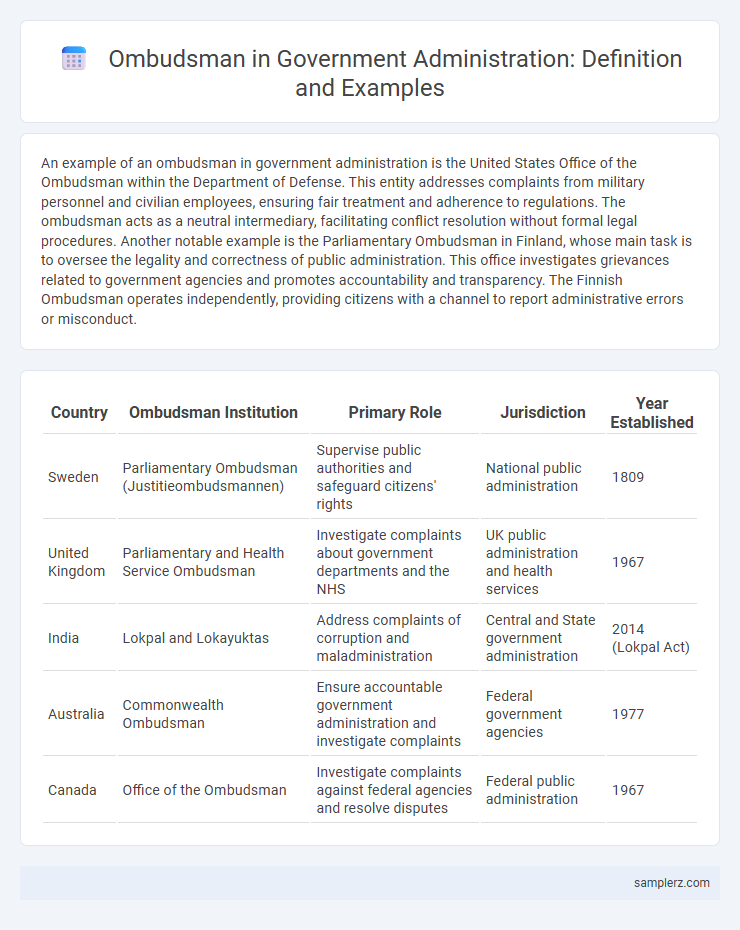An example of an ombudsman in government administration is the United States Office of the Ombudsman within the Department of Defense. This entity addresses complaints from military personnel and civilian employees, ensuring fair treatment and adherence to regulations. The ombudsman acts as a neutral intermediary, facilitating conflict resolution without formal legal procedures. Another notable example is the Parliamentary Ombudsman in Finland, whose main task is to oversee the legality and correctness of public administration. This office investigates grievances related to government agencies and promotes accountability and transparency. The Finnish Ombudsman operates independently, providing citizens with a channel to report administrative errors or misconduct.
Table of Comparison
| Country | Ombudsman Institution | Primary Role | Jurisdiction | Year Established |
|---|---|---|---|---|
| Sweden | Parliamentary Ombudsman (Justitieombudsmannen) | Supervise public authorities and safeguard citizens' rights | National public administration | 1809 |
| United Kingdom | Parliamentary and Health Service Ombudsman | Investigate complaints about government departments and the NHS | UK public administration and health services | 1967 |
| India | Lokpal and Lokayuktas | Address complaints of corruption and maladministration | Central and State government administration | 2014 (Lokpal Act) |
| Australia | Commonwealth Ombudsman | Ensure accountable government administration and investigate complaints | Federal government agencies | 1977 |
| Canada | Office of the Ombudsman | Investigate complaints against federal agencies and resolve disputes | Federal public administration | 1967 |
Introduction to the Role of Ombudsman in Government Administration
The ombudsman in government administration serves as an independent authority tasked with investigating complaints against public agencies and ensuring accountability. This role is crucial for promoting transparency, protecting citizens' rights, and resolving disputes without judicial intervention. By addressing maladministration and fostering trust in public institutions, the ombudsman enhances the quality of governance and public service delivery.
Historical Development of Administrative Ombudsman
The concept of the administrative ombudsman originated in Sweden in 1809 with the establishment of the Parliamentary Ombudsman to oversee public authorities and safeguard citizens' rights. This model spread globally as governments adopted ombudsman institutions to promote transparency and accountability in public administration. Historical development highlights the adaptation of the ombudsman role to reflect varying legal systems while maintaining the core mission of independent complaint investigation and resolution.
Key Functions and Responsibilities of an Ombudsman
An ombudsman in government administration serves as an independent intermediary who investigates public complaints against maladministration or violation of rights. Key functions include resolving disputes impartially, ensuring transparency, and recommending corrective actions to improve public services. Responsibilities extend to monitoring compliance with laws, enhancing accountability, and protecting citizens from unfair treatment by government agencies.
Global Examples of Administrative Ombudsman Offices
The Office of the Ombudsman in the Philippines investigates government corruption and administrative misconduct, providing citizens a direct channel for complaints against public officials. Sweden's Parliamentary Ombudsman serves as a model for many countries, overseeing the legality of public administration and protecting citizens' rights. India's Central Vigilance Commission acts as an anti-corruption ombudsman, promoting integrity and transparency in government agencies.
Case Study: The Swedish Parliamentary Ombudsman
The Swedish Parliamentary Ombudsman, established in 1809, serves as a pivotal institution in holding public authorities accountable and safeguarding citizens' legal rights. This office investigates complaints against government agencies, ensuring compliance with laws and ethical standards through impartial oversight. By promoting transparency and rectifying administrative abuses, the Swedish Parliamentary Ombudsman exemplifies effective mechanisms for government accountability and citizen protection in democratic governance.
Ombudsman in Local Government: Practical Applications
The Local Government Ombudsman addresses complaints about maladministration and service failures in councils, providing an independent resolution mechanism for citizens. This office investigates issues such as planning decisions, housing disputes, and social care services, ensuring transparency and accountability in local authorities. By offering recommendations and remedies, the Ombudsman enhances trust and improves public service delivery in municipal governance.
Impact of Ombudsman on Public Administration Transparency
The Ombudsman serves as a crucial mechanism in enhancing public administration transparency by investigating complaints and addressing maladministration. By providing an independent oversight function, the Ombudsman promotes accountability and fosters trust between government institutions and citizens. This role significantly reduces corruption and procedural inefficiencies, resulting in more transparent and responsive governance.
Challenges Faced by Ombudsman in Administrative Oversight
Ombudsmen in administrative oversight frequently encounter challenges such as limited investigative powers, bureaucratic resistance, and insufficient funding, which impede their ability to effectively address public grievances. Navigating complex legal frameworks and ensuring impartiality while maintaining confidentiality further complicate their oversight functions. These constraints often result in delayed resolutions and reduced accountability within government agencies.
How Citizens Access and Utilize Ombudsman Services
Citizens access ombudsman services through official government websites, dedicated hotlines, and local administrative offices where complaints can be submitted in person or online. The ombudsman facilitates investigations into public administration grievances, ensuring transparency and accountability by providing impartial resolution mechanisms. Utilization often involves filing complaints related to bureaucratic delays, unfair treatment, or administrative errors, supported by clear guidelines and public awareness campaigns to enhance accessibility.
Future Trends in Ombudsman Institutions within Government
Emerging trends in government ombudsman institutions emphasize the integration of artificial intelligence to enhance case management and improve citizen access to services. Increased transparency initiatives and real-time data analytics enable more effective monitoring of administrative fairness and accountability. These innovations position ombudsman offices as pivotal facilitators of trust and responsiveness in public administration.

example of ombudsman in administration Infographic
 samplerz.com
samplerz.com